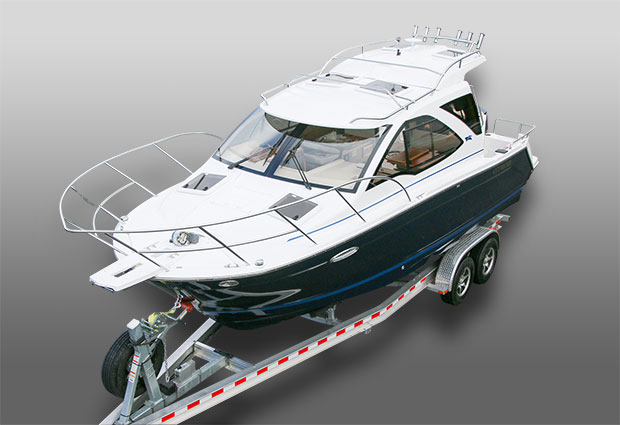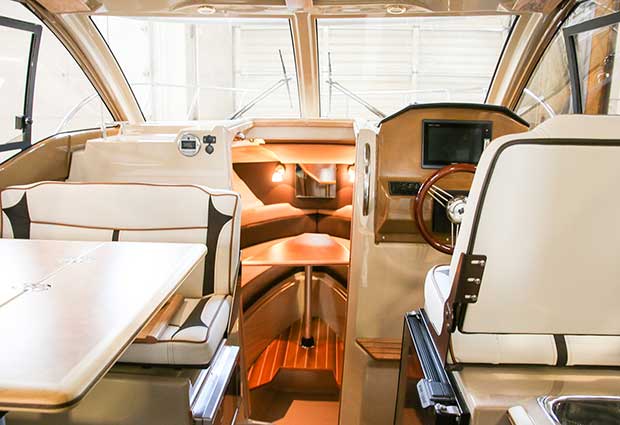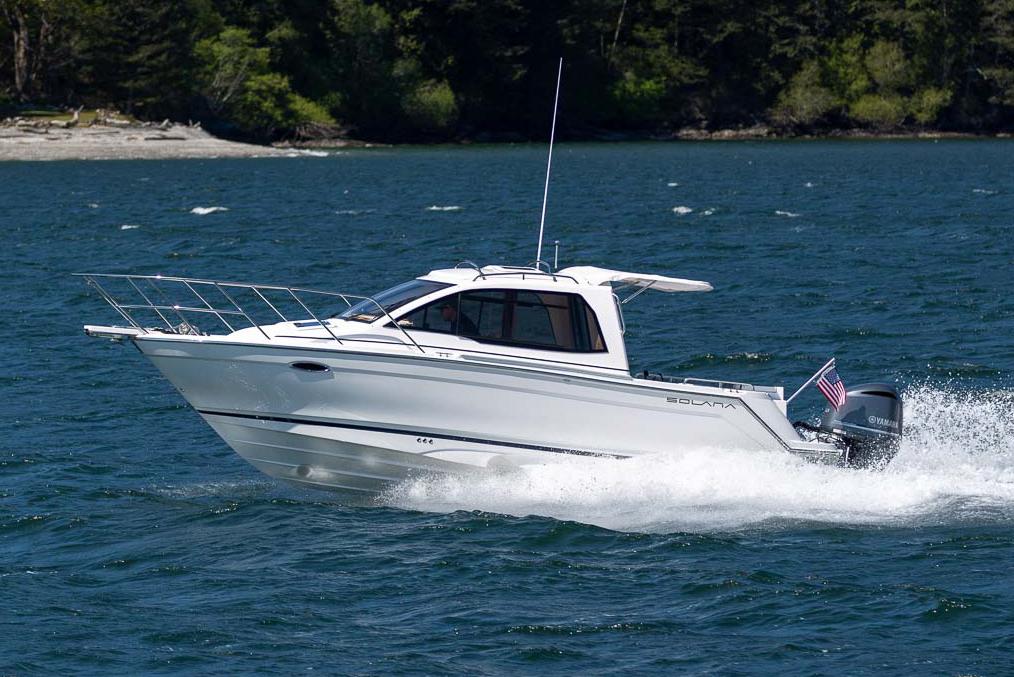Advertisement
Advertisement
Cutwater Solara 24: a Pocket Cruiser with Punch
Pint-sized but powerful, the newest addition to the Cutwater line of single-screw cruisers offers trailering convenience and plenty of space for a couple on short coastal hops.
February 22, 2015
Fluid Motion, the builder of Ranger Tugs and Cutwater Boats, has just launched the Cutwater Solara 24, the smallest in a fleet of pocket cruiser models that ranges up to the Cutwater 30. After spending time aboard hull number one at the Vancouver boat show, I came away impressed with the innovative details throughout this tiny package.
At 24 feet long and just eight and half feet wide, the Solara is trailerable without a permit—which makes it ideal for anyone wanting to gunkhole in the San Juan Islands and then pull the boat along the nation’s interstate network, to continue the adventure. There are three propulsion options on this model: the standard Volvo 240 hp V-6 fuel-injected gas inboard with Duo Prop sterndrive; an optional Volvo 220 hp diesel with sterndrive; and an optional F300 Yamaha outboard.
The economical inboard models weigh approximately 5,300 pounds and the outboard version comes in at 4,900 pounds, so a full-sized pickup truck should be all that’s needed for complete versatility. With the outboard version, repowers become as easy as hanging a new engine on the transom and the unused engine space under the cockpit sole can be used for stowage.
The hull features a full bow forward and a sloping sheerline to lower sides aft. But it’s what’s underneath that gets really interesting. The hull is double-stepped to introduce air amidships and create lift. Forward, there is a patch of dimples that Fluid Motion calls Laminar Flow Interrupters. These small indentations function like the surface of a golf ball. The idea is to break up the surface tension of the surrounding water (like a golf ball does with air) thereby providing less resistance and an easier, more economical ride. I have no concrete percentages on any increased efficiency due to these dimples, but they do spawn interesting conversations at the launch ramp.
Onboard, it’s like a treasure trove of fun details. Stainless-steel railings line the cabin top so it’s not difficult to walk along the side decks from cockpit to bow, where there’s an optional electric windlass in an opening anchor locker. Two hatches on the cabin top and two in the bow deck provide lots of light and ventilation below, assisted by opening side windows.
Clear views are available 360 degrees, which is part of what makes this small boat seem big from inside. The entry door aft is glass and the window next to it hinges and locks up against the hard overhang, which also supports a row of (optional) rocket launchers. With the window open and the backrest of the interior settee swung forward, this area becomes additional cockpit seating. Very neat.
Inside, the compact galley is to starboard and features an alcohol/electric cooktop and a 12V refrigerator/freezer. The helm seat at the forward end of the galley flips up when not in use to reveal more food-prep space. A microwave is tucked in under the companion seat.
To port is a dinette which can seat two comfortably or four in a pinch. The edge of the hi/lo table flips up and out of the way to reveal nicely engineered cupholders, and the entire area converts to a berth if necessary. And speaking of sleeping spaces–if you have kids along they’ll love the cubby under the settee, which can function as an extra berth or a stowage area. Another example of out-of-the-box thinking is the double companion seat, that goes from facing aft toward the table, to facing forward. It’s an unusual mechanism that swings the entire seat and uses no more space to do double-duty.
| Specifications | |
|---|---|
| Length | 23'7" |
| Beam | 8'6" |
| Draft | 3'1" |
| Displacement | 4,900 lbs |
| Fuel capacity | 120 gal. |
| Water capacity | 30 gal. |
The helm station is well-laid out with engine controls and a single Garmin multifunction display for chartplotter and radar functionality. Step down to the sleeping quarters in the V-berth. A hi/lo table drops down and forms a wide berth with a filler cushion. This will work great for two, but they’d better not be tall. At 5’ 5” I took up most of the length of one side. There’s a full marine head to starboard and a sink to port, and although it was not yet installed on the model I saw, there’s supposed to be a curtain that provides privacy in this area.
The interior finish is a maple and cherry wood combination and ample LED lighting gives the boat a warm glow. Besides engine choices, there are a few other options available including dockside air conditioning, a bow thruster, an inverter and AGM batteries, two 19” flatscreen TVs, and of course, the trailer. You can customize this small vessel ad infinitum and because the base price is just under $100,000, you can afford to add quite a bit to make this pocket cruiser a perfect cruising partner with a punch.
Other Choices: There really aren't many micro-cruisers like this around. You could look at a boat like the Bayliner Discovery 266 or the Gurnet Point 25, but you'll be mixing apples and oranges. There are some more similar models built and sold in Europe, like the Parker 770 Weekender, but these can be difficult if not impossible to find locally.
See Cutwater 24 Solara listings.
For more information, visit Cutwater.
Advertisement
Advertisement














